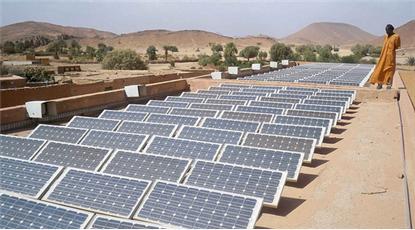It is becoming increasingly apparent that the current plummet in oil prices is driven in part by OPEC’s desire to hurt the North American shale oil industry. Could they also be looking at a future in the solar market?
Speaking at the opening day of the fourth Solar Arabia summit in Riyadh in October of last year, Hamed al-Saggaf, executive director of the Saudi Electricity Company, told attendees that the kingdom must learn to wean itself off its dependence on oil and gas for electricity production.
“If we continue to consume fuel at the same rate, then there will be a great lost opportunity,” Saggaf said. “We have to start pursuing solar now.”
With a peak electricity load of 57 GW and a growing, power-hungry middle class, Saudi Arabia has begun to give greater consideration to its energy future, especially with the increasingly politicized oil market.
In a recent article for Market Watch, Satyajit Das (author of Traders, Guns & Money) wrote: “In theory, Saudi Arabian oil and foreign policy are separate. In practice, they are related. Low oil prices hurt Iran, Saudi Arabia’s competitor for Middle East political influence…. Low oil prices also hurt Russia, which also supports Syria and Iran. Low prices also undermine the financial basis of Islamic State militants, whose sales of cheap smuggled oil funds their military activities….Low oil prices can be seen through a Saudi prism as reprisals against the U.S. It is designed to undermine American attempts at greater energy self-sufficiency through aggressive exploitation of its shale gas and liquid resources. It is revenge for America’s strategic rebalancing away from the region to a greater Asian focus. The oil strategy is a signal from Saudi Arabia that it still wields significant power on the geopolitical stage.”
Now, solar is playing an odd supporting role in Saudi Arabia’s game of economic/political energy brinksmanship. The solar industry has struggled to take off in the energy rich nation, despite the obvious solar assets the desert nation has. Now, with a battle on over oil, there appears to be a somewhat counter-intuitive spike in interest in solar for the Saudis. What solar seems to be providing is not only security from the perspective of the utility sector, but also a potential future energy export.
- Just last month, it was announced that General Electric (GE) has won a contract to supply a 600 MW integrated solar combined-cycle power plant for the Green Duba project in Saudi Arabia, according to recent reports. It is being developed in the Saudi port-city of Duba by the country’s utility, the Saudi Electricity Company. The project represents what is expected to be a series of concentrating solar combined-cycle power plants.
- This week, Dubai Electricity and Water Authority announced on Thursday that a consortium of Saudi Arabia’s ACWA Power and Spain’s TSK had been selected to build a solar power plant in the UAE emirate. The utility’s chief executive, Saeed Mohammed Al Tayer, also announced that the size of the plant, Phase Two of the Sheikh Mohammed bin Rashid Al Maktoum Solar Park, would be increased to 200 MW of generating capacity from the previous target of 100 MW.
- A consortium led by Saudi Arabia’s ACWA Power International has won a 1.7 billion euro contract to build two solar power plants totaling 350 megawatts in the southern Moroccan city of Ouarzazate, according to the Moroccan solar energy agency. The two plants are the second phase of the 500 MW Ouarzazate project, which is part of a government plan to produce two gigawatts of solar power by 2020, equivalent to about 38 per cent of Morocco’s current installed generation capacity.
Is Saudi Arabia quietly moving to expand their energy dominance into the electricity sector? It is not beyond the realm of possibility that Saudi-built solar generation could be delivering power into the European Union’s grid in the next 10 to 20 years.

Desertec was an ambitious project to do just that, launched in 2003. The German-led initiative aimed to provide 15% of Europe’s electricity by 2050 through a vast network of solar and wind farms stretching right across North Africa and the Mediterranean region and connecting to Europe via special high voltage, direct-current transmission cables, which lose only around 3% of the electricity they carry per 1,000 kilometers. The tentative total cost of building the project has been estimated at 400 billion euros.
As of this writing, it would appear as if Desertec has bitten the dust, with a major exodus of European investors. However, with the recent Saudi/Spanish solar deals, it looks like the Saudi’s may be picking up some of the pieces, and it wouldn’t be surprising to see a push to complete the Morroco-Spain grid link. Will the Saudi’s make a move to deliver solar to the EU’s grid?
The implications are serious. Large amounts of inexpensive solar electricity pouring onto the European grid could have an effect similar to that shock currently being felt by the fledgeling US shale oil industry.





